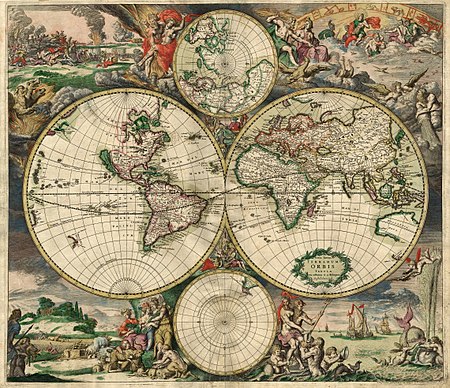World History
The World History Project
Welcome to the World History Project. This organization is dedicated to making a free, open-content, standardized textbook on World History based on the AP World History Standard. The goal is to create a standard of quality which will suffice for a secondary and post-secondary environment. The World History Project is the "brains" behind the organization. We are a set of regular contributors who organize and give the major guidance to the World History page. We welcome contribution of any who wish to help (whether as part of the World History Project or no), as well as collaboration with other projects - contact us here at our main discussion page or here at our Authors page.

| “ | Those who cannot remember the past are condemned to repeat it... | ” |
—George Santayana | ||
| “ | If history always repeats itself, and we are to expect the unexpected, how incapable must man be to not learn from it? | ” |
—Farmers Almanac | ||
Standards | Our Golden Rule | The Authors | Maps | Resources | Contributors' Corner
- Operation: Blank Check- Finalization of structure and basic articles- See The Rise of Dictatorship and Totalitarianism for an example of the type of article completeness desired Current
Prologue - An Introduction to World history and the Advanced Placement examination
Period 1- Technological and Environmental Transformations, to c. 600 B.C.E
- Big Geography- Peopling of the Earth
- Ancient Civilizations - The Beginning of Agriculture and Ancient Cultures
- The First Chinese Dynasties - From Mythical Period to The Xia, Shang, and Zhou dynasties
- Civilization and Empires in the Indian Subcontinent - Indus Valley Civilization and the Mauryan and Gupta Empires
- World Religions - Religions of the past
- Ancient Greece and Alexander the Great - From Minoans to the rise of Hellenistic Empires, through Alexander the Great
Period 2- Organization and Reorganization of Human Societies, c. 600 B.C.E. to c. 600 C.E.
- The Roman Empire
- The Unification of China
- Middle Eastern Empires and the spread of Islam.
- The Middle Ages in Europe- - The beginning of the west
- The Norman empire- - The beginning of England
- Precolumbian History of the Americas - Immigration of ancient peoples, Mexico, Mesoamerica, and North/South America
- Ancient Kingdoms of Africa - Eastern and Western African nations through colonization
Period 3- Regional and Interregional Interactions, c. 600 C.E. to c. 1450
- Samo's Empire - The beginning of Czechia, Slovakia and Austria
Period 4- Global Interactions, c. 1450 to c. 1750
- Changes in Eurasia - Mongol Conquest and Aftermath
- The Renaissance in Europe
- Age of Discovery & Imperialism
- Religious Wars in Europe
- The Rise of Nationalism and the Nation-state
- Revolution, Change, and philosophy - English Civil War and Bill of Rights, American, French, and Glorious Revolutions, the spread of Democratic and Libertarian ideas
- Napoleonic Europe and Reactionism
Period 5- Industrialization and Global Integration, c. 1750 to c. 1900
- The Industrial Revolution - Its beginnings and consequences.
- Changes in East Asia
- The Age of Imperialism, Part II
Period 6- Accelerating Global Change and Realignments, c. 1900 to the Present
- Causes and course of the First World War
- Effects of the First World War
- The Russian Socialist Revolution - The Russian Revolution, Civil War, and the advent of Communism
- The Interwar Years - The Great Depression and the changes in society and culture during the interwar period
- The Rise of Dictatorship and Totalitarianism - Fascism and the like.
- Causes and course of the Second World War - The Axis and Allies.
- Consequences of the Second World War - The shift of powers, and the change of world order.
- The Collapse of Imperialism - Freedom, Change, and Revolution - The end of the Empires
- The Cold War
- The World Economy
- A New Millennium - Challenges and developments in the present day.